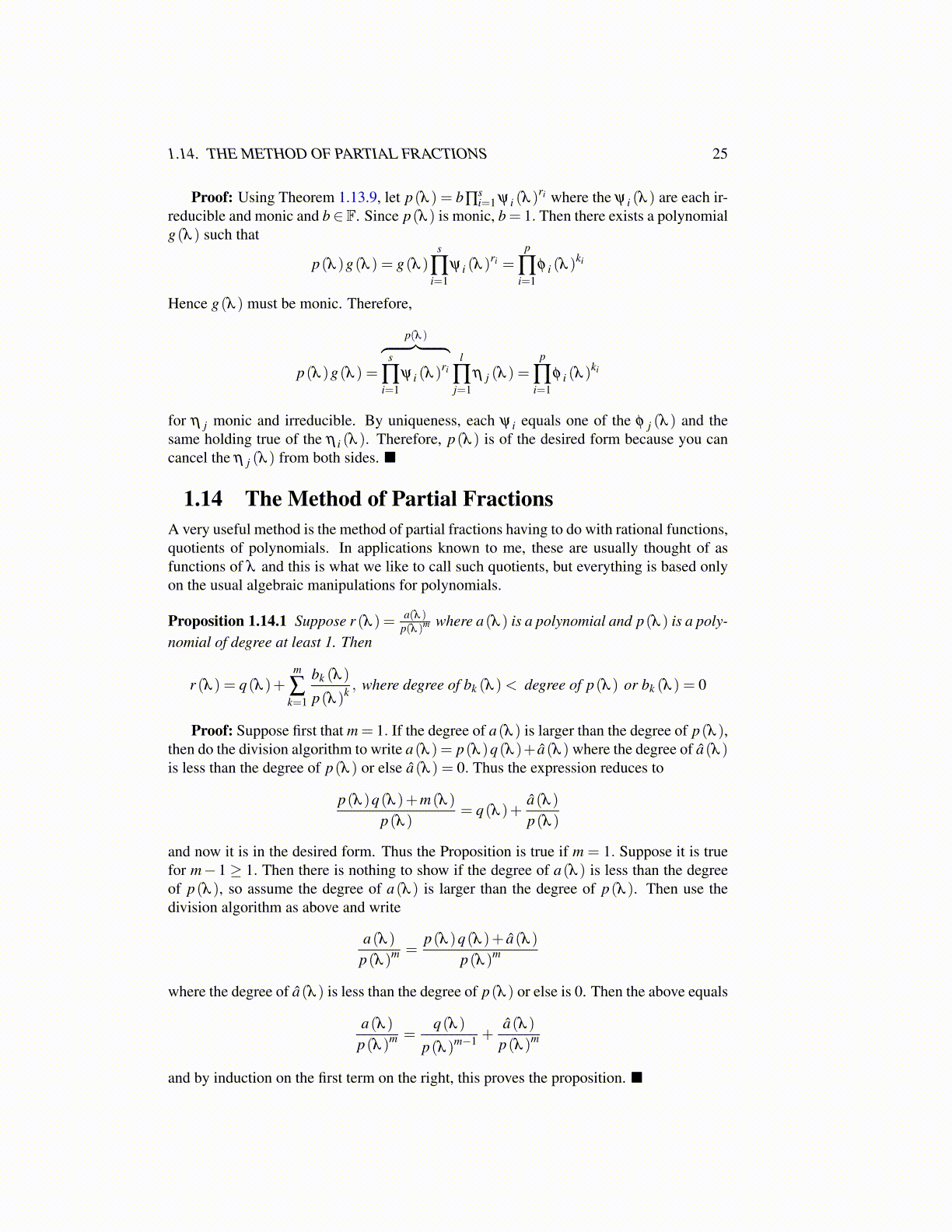
1.14. THE METHOD OF PARTIAL FRACTIONS 25
Proof: Using Theorem 1.13.9, let p(λ ) = b∏si=1 ψ i (λ )
ri where the ψ i (λ ) are each ir-reducible and monic and b∈ F. Since p(λ ) is monic, b = 1. Then there exists a polynomialg(λ ) such that
p(λ )g(λ ) = g(λ )s
∏i=1
ψ i (λ )ri =
p
∏i=1
φ i (λ )ki
Hence g(λ ) must be monic. Therefore,
p(λ )g(λ ) =
p(λ )︷ ︸︸ ︷s
∏i=1
ψ i (λ )ri
l
∏j=1
η j (λ ) =p
∏i=1
φ i (λ )ki
for η j monic and irreducible. By uniqueness, each ψ i equals one of the φ j (λ ) and thesame holding true of the η i (λ ). Therefore, p(λ ) is of the desired form because you cancancel the η j (λ ) from both sides. ■
1.14 The Method of Partial FractionsA very useful method is the method of partial fractions having to do with rational functions,quotients of polynomials. In applications known to me, these are usually thought of asfunctions of λ and this is what we like to call such quotients, but everything is based onlyon the usual algebraic manipulations for polynomials.
Proposition 1.14.1 Suppose r (λ ) = a(λ )p(λ )m where a(λ ) is a polynomial and p(λ ) is a poly-
nomial of degree at least 1. Then
r (λ ) = q(λ )+m
∑k=1
bk (λ )
p(λ )k , where degree of bk (λ )< degree of p(λ ) or bk (λ ) = 0
Proof: Suppose first that m = 1. If the degree of a(λ ) is larger than the degree of p(λ ),then do the division algorithm to write a(λ ) = p(λ )q(λ )+ â(λ ) where the degree of â(λ )is less than the degree of p(λ ) or else â(λ ) = 0. Thus the expression reduces to
p(λ )q(λ )+m(λ )
p(λ )= q(λ )+
â(λ )p(λ )
and now it is in the desired form. Thus the Proposition is true if m = 1. Suppose it is truefor m− 1 ≥ 1. Then there is nothing to show if the degree of a(λ ) is less than the degreeof p(λ ), so assume the degree of a(λ ) is larger than the degree of p(λ ). Then use thedivision algorithm as above and write
a(λ )p(λ )m =
p(λ )q(λ )+ â(λ )p(λ )m
where the degree of â(λ ) is less than the degree of p(λ ) or else is 0. Then the above equals
a(λ )p(λ )m =
q(λ )
p(λ )m−1 +â(λ )
p(λ )m
and by induction on the first term on the right, this proves the proposition. ■